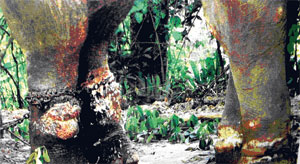Sindu and Raju are not the only elephants handed over to the Dalada Maligawa at the request of the Diyawadana Nilames (DN). In 2007, the Department of Wildlife Conservation (DWC) came under pressure to release a wild elephant brought to the Maligawa to be tamed. Dr.Vijitha Perera, a veterinary surgeon attached to the DWC, described the sad fate of this elephant in his book “Ten Years with the Wild Elephants” (Wana Ali Samaga Dasa Wasarak).
“During its seven months in captivity at Mawanella, this elephant never slept. A dip in water to cool the body heat is a common practice of jumbos, but this elephant was taken to the river only three times during its seven-month ‘prison-like’ life. In the wilds, he could have walked 15/20 kilometres a day, but not even 100 metres during the time mahouts tried to tame him,” wrote Dr. Perera in his book.
Suffering from wounds caused by chain cuts, the elephant given to the Dalada Maligawa died.
 |
| Majestic elephant died as a result of deep chain cuts on its legs. |
But this remained an under-reported event, covered up by officials, until Dr. Perera exposed it in his book.
“The fate of this elephant is my saddest experience during my career as a wildlife veterinarian,” Dr. Perera said. It was a mature wild elephant that roamed freely at Athiliwewa in Handapanagala. The elephant was captured by a team led by Dr. Perera on April 2, 2007, following complaints from villagers. While waiting for orders to release the elephant into a protected area, the team received an order from the DWC to hand the animal over to the Dalada Maligawa, without even conducting a primary investigation to see whether the elephant was suitable for domestication .
The fact that the elephant was about 40 years old and too old for domestication was completely overlooked. The animal also suffered several gunshot wounds as a result of encounters with villagers. The pleas of experts and veterinarians fell on deaf ears.
With heavy hearts, Dr. Vijitha and his team despatched the elephant to Mawanella, where an elephant taming ground was located on the Ma-Oya river banks. A day after the elephant arrived there, the ropes used to tie the elephant were removed and replaced with chains. The restless elephant wanted to break free, and tried to break the chains. As a result, its four legs suffered deep chain cuts. The wounds became infected, causing the elephant great suffering. Chain parts were embedded in the wounds. The animal’s life was saved, thanks to powerful anti-biotic treatment.
No official name was given to this elephant, although a mahout called it ‘Samanalaya’ (Butterfly). “The drowsy looking elephant suffering from pain and fear reminded one of a butterfly that had broken its wings and was awaiting death,” Dr. Perera said in his book.
To make matters worse, a gunshot wound near the jumbo’s tail also became infected. A veterinarian who looked after Maligawa elephants decided to operate on the elephant. He removed parts of the broken vertebrae too. The elephant was unable to rise on its legs, even though tranquillisers were administered. Fearing the elephant would not be able to stand up again, the authorities sought the DWC’s help. The elephant had been propped up with the help of a scaffolding.
DWC veterinarians visited the elephant with Dr. Perera. After their treatment, the elephant started to show signs of recovering.
But two months later, the elephant collapsed again. The Maligawa veterinarian resumed treatment, but there was no improvement.
Attempts to save the elephant continued till the next day. Around 3pm, the elephant started to shake violently, and after struggling for 30 minutes, the animal breathed its last. |

